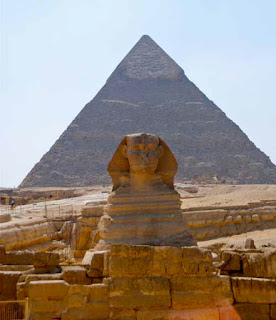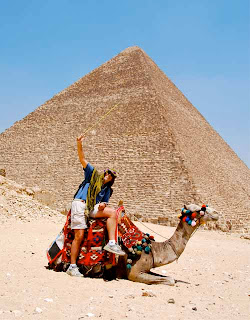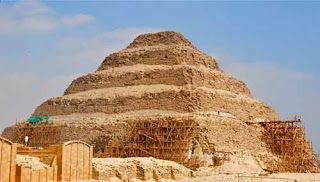 |
| Great Sphinx and Pyramid of Khafre - Giza, Egypt |
 |
| Camels and the Pyramids - Giza, Egypt |
 |
| Muslim Women at the Great Pyramid of Khufu - Giza, Egypt |
 |
| Wayne at Great Pyramid of Khufu - Giza, Egypt |
 |
| Egyptian Twirling - Giza, Egypt |
 |
| Great Pyramid of Krufu - Giza, Egypt |
 |
| Step Pyramid - Giza, Egypt |
 |
| Pat Riding Camel at Great Pyramids - Giza, Egypt |
 |
| Egyptian School Boys - Giza, Egypt |
 |
| Pat at Mena House Oberoi Hotel with Great Pyramid - Giza, Egypt |
The Great Pyramid of Khufu is one of the new Seven Wonders of the World and it should be! It is also the oldest and only remaining intact of the Seven Wonders of the Ancient World.
The oldest and largest of the three pyramids in the Giza area, the Great Pyramid of Khufu (see photos) was built as a tomb for fourth dynasty Pharaoh Khufu and constructed over a 20-year period concluding around 2551 BC. It was the tallest man-made structure in the world for over 38 centuries.
What is seen today is the underlying core structure - originally the Great Pyramid of Khufu was covered by smooth white stones that glistened in the sun.
It is estimated that the Great Pyramid of Khufu consists of about 2.3 million limestone blocks weighing about 2.5 tons each. Building this in 20 years would involve installing 800 tons of stone every day (think about that!). The largest granite stones in the pyramid, found in the King's chamber, weigh 25 to 80 tons and were transported more than 500 miles away from Aswan.
There have been varying scientific and alternative theories about the Great Pyramid's construction techniques. Most accepted construction hypotheses are based on the idea that it was built by moving huge stones from a nearby quarry and dragging and lifting them into place.
Traditionally, ancient Egyptians cut stone blocks by hammering wooden wedges into the stone, which were then soaked with water. As the water was absorbed, the wedges expanded, causing the rock to crack. Once they were cut, the huge stones were carried by boat either up or down the Nile River to the pyramid.
Modern Egyptologists believe that the Great Pyramid of Khufu was built by many tens of thousands of highly organized skilled workers, not slaves. They camped near the pyramids and worked for a salary or as a form of paying taxes until the construction was completed.
Still impressive but smaller, the Pyramids of Khafre and Menkaure were built for the son and grandson of Khufu. Wayne climbed inside to the center of the Pyramid of Khafre to the burial chamber - not for the claustrophobic!
Like meeting a famous person, the lion-headed Great Sphinx of Giza (see photo) appears smaller in person than the images we have been exposed to, especially next to the Giza pyramids.
The step Pyramid of Saqqara (see photo) near Memphis is significant because it was one of the first great pyramids pre-dating the famous Great Pyramid of Krufu by 200 years. Essential engineering developments were proven here.
Also important were the Bent and North Pyramids where the builders of the Bent Pyramid changed the angle half way up – hey, live and learn.
 |
| Map of Egypt |
For more
about amazing Egypt and the Temples and treasures along the Nile River, please see
our 5 other blog posts:
and see our posts on Egypt’s
beautiful Red Sea resorts:
Please enjoy 250+ wonderful places around the world, with award-winning photos, from our BLOG ARCHIVE on the right ---->
Buy this popular book on Amazon.com (also available as Ebook for $9.99), CLICK HERE



Thanks for posting this blog, Yes The Great Pyramid of Khufu is one of the new Seven Wonders of the World, And All three of Giza’s pyramids had mortuary temples connecting to valley temples through a causeway. Really Egypt is best place for travel. Recently I am going to Egypt with the help of a travel company and I really impressed her services. Thanks Egypt trip Center and also thanks to you for such a nice blog.
ReplyDeleteThanks for this very nice blog post!
ReplyDeleteChris
www.the-cheapest-hotels.com
always the best deal...